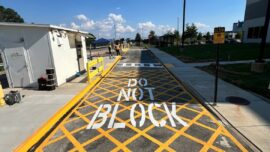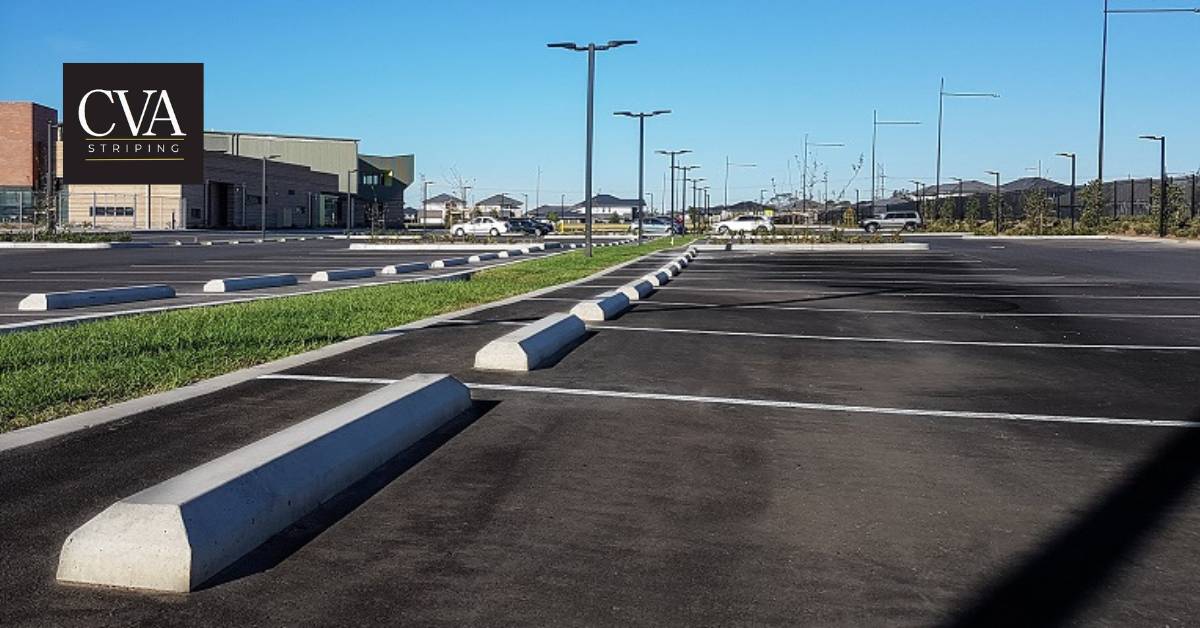
Essential Guide to Wheel Stop Dimensions: Sizes, Standards, and Installation Tips
Wondering about the wheel stop dimensions! CVA Striping knows how important it is to have a well-organized and safe parking lot. That’s why we’ve put together this comprehensive guide to help you understand everything you need to know about wheel stop dimensions, standards, and installation tips.
Whether you manage a small commercial parking lot or a large public facility, the right-wheel stops can significantly improve safety and efficiency. This guide covers the standard sizes of wheel stops, the types of materials available, proper placement standards, and best practices for installation. Let’s dive in and make sure your parking lot is as safe and efficient as possible, providing a secure environment for both drivers and pedestrians.
Understanding Wheel Stop Dimensions
Wheel stops, also known as parking blocks, come in various sizes to fit different needs. Typically, they range from 3 to 6 feet in length and vary in height and width to accommodate different vehicle sizes. Choosing the right dimensions for your parking lot helps ensure that vehicles are properly aligned and that pedestrian pathways remain clear.
What Are the Standard Sizes of Wheel Stops and Why Do They Matter?
Standard wheel stop sizes matter because they ensure consistency and safety across your parking lot. The most common dimensions are 6 feet long, 4 to 6 inches high, and 5 to 6 inches wide. These sizes are designed to stop vehicles effectively without causing damage. Properly sized wheel stops help prevent over-parking, which can block walkways and create hazards for pedestrians. By sticking to standard sizes, you also ensure compliance with local regulations and improve the overall management of your parking area.
Types of Wheel Stops for Parking Lots
Choosing the right type of wheel stop for your parking lot is crucial for ensuring safety and durability. Several materials are available, each with its own benefits and ideal applications. Let’s explore the various types of wheel stops available.
Concrete Wheel Stops
Concrete wheel stops are a popular choice due to their durability. They can withstand significant impacts and are ideal for high-traffic areas. Their weight ensures they stay in place, providing reliable performance over time. If you need something that’s going to last, concrete is a great option.
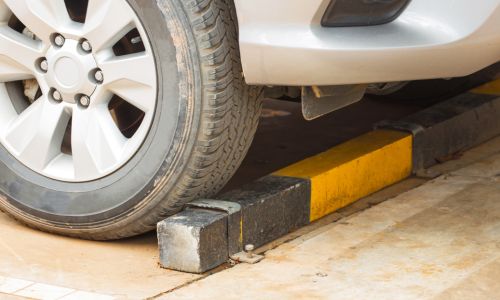
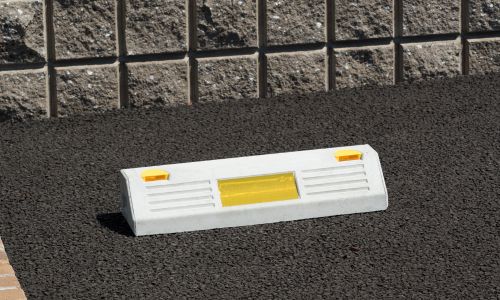
Rubber Wheel Stops
Rubber wheel stops are flexible and easy to install. Made from recycled materials, they’re an environmentally friendly choice. Rubber stops are less likely to damage vehicles upon impact and are great for areas where adjustments are frequently needed. They’re a versatile option for many parking lots.
Plastic Wheel Stops
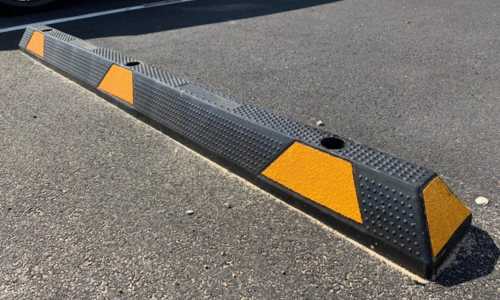
Plastic wheel stops in Richmond, VA are lightweight and easy to handle. They’re resistant to weather and chemicals, making them a durable solution for parking lot management. Despite being lighter than concrete, they can be securely anchored to ensure stability. If you need something quick and effective, plastic might be the way to go.
Detailed Wheel Stop Placement Standards for Optimal Safety and Compliance
Proper wheel stop placement is crucial for maintaining safety and compliance in parking lots. This section provides detailed guidelines on how to place wheel stops optimally to enhance safety and comply with regulations.
Optimal Placement for Safety
Correctly placing your wheel stops is key to ensuring safety in your parking lot. They should be positioned to allow enough space for vehicles to park without obstructing pedestrian pathways. Proper placement helps prevent vehicles from overhanging into walkways or other parking spaces, enhancing overall safety.
Regulations and Compliance
Compliance with local and national regulations is crucial when installing wheel stops. These regulations specify the required distances from the curb, the number of stops per parking space, and the materials allowed. Adhering to these standards ensures safety and helps you avoid legal issues.
Surface and Marking Requirements
The surface of ADA parking spaces must be smooth, stable, and slip-resistant to provide a safe and accessible environment for individuals with disabilities. The surface must be well-maintained and free of cracks or uneven areas that could pose a hazard. In addition to the surface quality, the markings on ADA parking spaces should be clear and easily visible. Using high-contrast colors for lines and symbols ensures that they stand out, making it easy for drivers to identify accessible spaces.
Recommended Distance Between Wheel Stops
The recommended distance between wheel stops is typically around 28 to 30 inches. This spacing ensures that the stops effectively prevent vehicles from rolling too far while allowing enough room for maneuvering. Proper spacing helps maintain order and safety in your parking lot.
Installation Tips for Wheel Stops
Proper installation of wheel stops is crucial for ensuring their effectiveness and durability. Here, we provide detailed tips and best practices to help you install wheel stops correctly and efficiently, ensuring long-term safety and functionality in your parking lot.
Tools and Materials Needed
To install wheel stops, you’ll need a few essential tools and materials. These include a drill with appropriate bits, anchors, or bolts, a measuring tape, chalk, or markers for outlining, and, of course, the wheel stops itself. Additionally, having a level can ensure that the wheel stops are placed evenly, and safety equipment such as gloves and goggles can protect you during the installation process. Having the right tools on hand will make the installation process smooth and efficient.
Step-by-Step Installation Guide
Installing wheel stops is easy if you follow these steps:
- Measure and mark the placement area to ensure accuracy.
- Drill holes into the marked spots on the pavement, making sure they are deep enough to secure the anchors or bolts.
- Position the wheel stop over the holes, aligning it properly with the marked outlines.
- Secure the wheel stop with anchors or bolts, ensuring they are tightened properly.
- Double-check the stability to ensure it’s firmly in place and make any necessary adjustments.
Common Installation Mistakes to Avoid
Avoiding common mistakes can save time and effort. Ensure that wheel stops are not placed too close to the curb, as this can cause vehicles to overhang into pedestrian areas. Make sure the stops are securely anchored to prevent movement, as loose stops can become a hazard. Lastly, check the alignment regularly to maintain consistency, as misaligned wheel stops can lead to uneven parking and potential accidents. Additionally, avoid using improper tools or insufficient anchors, as this can compromise the installation and effectiveness of the wheel stops. Regularly inspect the installation to ensure it remains secure and functional.
Benefits of Proper Wheel Stop Placement
Proper wheel stop placement in parking lots offers numerous advantages, enhancing safety, efficiency, and overall functionality. Let’s explore the key benefits.
Enhancing Parking Lot Safety
Proper wheel stop placement significantly enhances parking lot safety. It helps to prevent vehicles from moving beyond designated spaces and into pedestrian pathways, reducing the risk of accidents. Well-placed wheel stops ensure that cars are parked in an organized manner, maintaining clear sightlines for both drivers and pedestrians.
Preventing Vehicle Damage
Correctly installed wheel stops prevent vehicles from hitting obstacles, curbs, or other cars, minimizing the risk of damage to both vehicles and property. By providing a clear stopping point, wheel stops help prevent drivers from oversteering and damaging their vehicles, reducing the likelihood of costly repairs.
Improving Traffic Flow
Well-placed wheel stops improve traffic flow within the parking lot. They guide drivers to park correctly, ensuring efficient use of space and reducing congestion. By clearly defining parking spaces, wheel stops help drivers maneuver their vehicles smoothly, decreasing the chances of traffic jams.
Increasing Pedestrian Safety
Wheel stops enhance pedestrian safety by keeping vehicles within designated areas. Clear pathways and reduced vehicle encroachment make it safer for people to walk through the parking lot. This added safety measure is especially important in areas with high foot traffic, such as shopping centers and schools.
Reducing Maintenance Costs
Properly installed and maintained wheel stops can reduce long-term maintenance costs. They prevent vehicles from causing damage to landscaping, curbs, and other structures, saving on repair expenses. Regular inspections and timely replacements ensure wheel stops remain effective, further reducing the need for frequent maintenance.
How Often Should Wheel Stops Be Inspected and When Is Replacement Necessary?
Regular inspection of wheel stops is essential to ensure they remain effective and safe. We recommend inspecting them at least twice a year or more frequently in high-traffic areas. During these inspections, check for signs of wear and tear, movement, and damage, such as cracks or significant fading of markings.
It’s also important to ensure that the wheel stops are still securely anchored in place and have not shifted. Replace wheel stops if they show significant signs of wear, if they no longer stay securely in place, or if they have been damaged by vehicles or weather conditions. Keeping wheel stops in good condition not only maintains safety but also helps comply with ADA regulations and maintains the overall aesthetics of the parking lot.
FAQs About Wheel Stop Dimensions
What Are the Standard Dimensions for Wheel Stops?
Standard wheel stop dimensions are typically 6 feet long, 4 to 6 inches high, and 5 to 6 inches wide. These sizes are effective in stopping vehicles without causing damage.
How Should Wheel Stops Be Placed in a Parking Lot?
Wheel stops should be placed to allow enough space for vehicles to park without obstructing pedestrian pathways. The recommended distance between wheel stops is around 28 to 30 inches.
What Materials Are Best for Wheel Stops?
Wheel stops can be made from concrete, rubber, or plastic. Each material has its benefits, with concrete offering durability, rubber providing flexibility and environmental benefits, and plastic being lightweight and easy to install.
Are There Specific Regulations for Wheel Stop Placement?
Yes, there are specific regulations for wheel stop placement. These include distances from the curb, the number of stops per parking space, and the materials allowed. Compliance with these regulations is essential for safety and legal purposes.
How Often Should Wheel Stops Be Inspected and Maintained?
Wheel stops should be inspected at least twice a year or more frequently in high-traffic areas. Regular maintenance ensures they remain effective and safe, and replacements should be made when significant wear or movement is observed.
Can Wheel Stops Be Customized for Specific Needs?
Yes, wheel stops can be customized to meet specific needs. Custom dimensions and materials can be chosen to suit particular requirements, ensuring the best fit for your parking lot.


